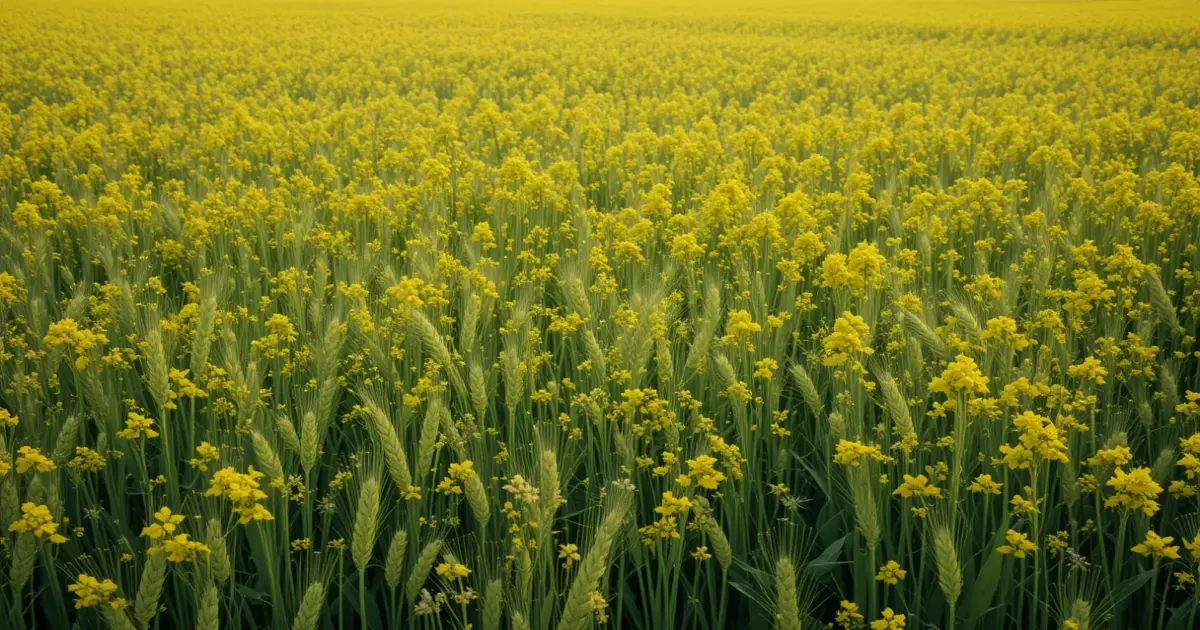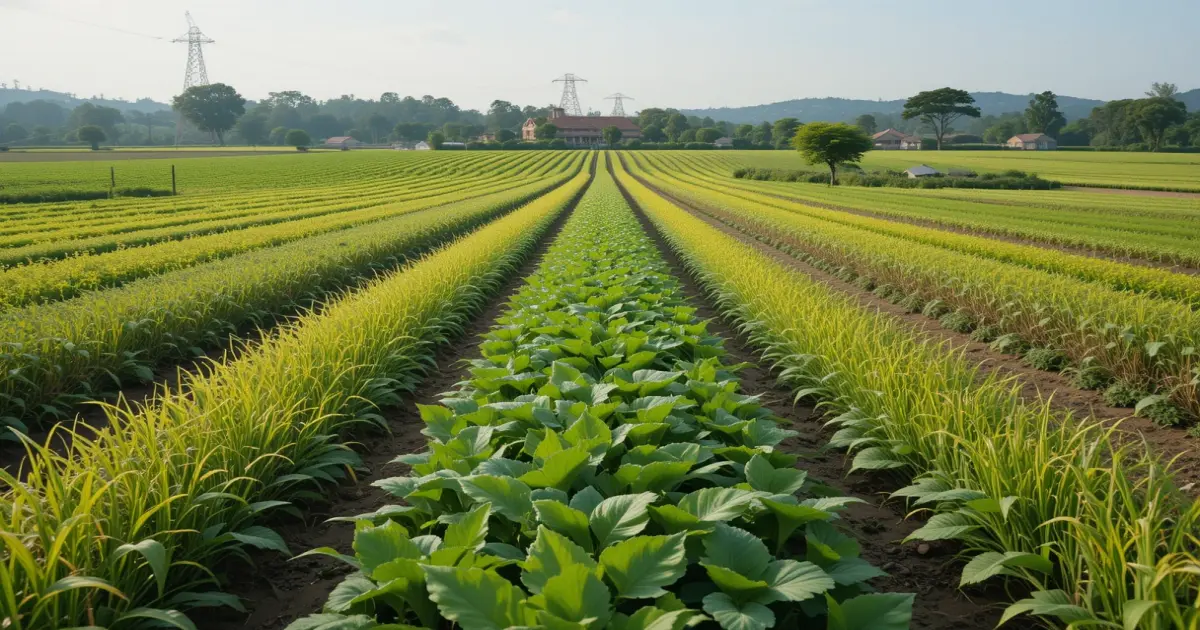Farmers constantly seek ways to boost yields and protect crops from unpredictable weather and pests. Mixed cropping and intercropping are two proven techniques that improve harvests and promote sustainability. These methods involve growing multiple crops together, but they differ in planning and arrangement.
Mixed cropping helps reduce the risk of total crop failure by combining crops that complement each other. Intercropping, on the other hand, follows a structured pattern to enhance resource use and soil health. Both techniques support biodiversity, improve food security, and reduce dependency on chemical inputs.
As climate change threatens global agriculture, adopting these sustainable practices is more important than ever. This post will explore the concepts, benefits, and key differences between mixed cropping and intercropping.
What is Mixed Cropping?
Mixed cropping is the practice of growing two or more crops together in the same field without a fixed pattern. This method helps farmers reduce risks caused by droughts, pests, or diseases. If one crop fails, the other can still provide a harvest.
The main goal of mixed cropping is to ensure yield stability and better land use. It also improves soil fertility by using crops with different nutrient needs. For example, wheat and mustard or maize and beans are commonly grown together.
Mixed cropping benefits small farmers who rely on natural farming methods. It minimizes the need for chemical fertilizers and pesticides, making it an eco-friendly choice. However, managing different crops together can be challenging, especially when they have varying growth rates.

What is Intercropping?
Intercropping is a planned farming method where two or more crops are grown in specific arrangements. Unlike mixed cropping, crops are placed in rows, strips, or alternating patterns. This strategic approach maximizes space, light, and nutrient absorption.
The main aim of intercropping is to enhance crop interaction for better growth and productivity. Some crops provide shade or repel pests, benefiting their companions. For example, maize is often intercropped with cowpea, and sugarcane with onion.
Intercropping promotes biodiversity and soil health while reducing pest outbreaks. It also helps farmers earn more by growing multiple crops in the same area. However, it requires careful planning to avoid competition between crops for water, sunlight, and nutrients.
Key Differences Between Mixed Cropping and Intercropping
| Features | Mixed Cropping | Intercropping |
| Crop Arrangement | No fixed pattern – in mixed cropping, no specific pattern is followed to grow crops together. | Planned rows or strips – in intercropping, crops are grown in organized rows or strips. |
| Resource Use | Less efficient – crops may compete for nutrients, water, and sunlight, leading to uneven growth | Maximizes space, nutrients, and light – each crop is positioned to use resources efficiently. |
| Pest Control | Moderate protection – some pest reduction occurs, but not as effectively as in intercropping. | Stronger pest and disease resistance – certain crops repel pests, reducing the need for pesticides. |
| Yield Stability | Reduces crop failure risk – if one crop fails, the other may still provide a harvest. | Increases overall productivity – planned arrangements improve growth, leading to higher total yield. |
Mixed cropping focuses on reducing risks, while intercropping improves efficiency. Farmers choose the method based on land availability, climate, and crop types.
Benefits of Mixed Cropping and Intercropping
Farmers face many challenges, such as unpredictable weather, soil degradation, and pest infestations. Mixed cropping and intercropping help overcome these issues by increasing crop resilience and improving soil health.
These methods also enhance biodiversity, making farms more sustainable and productive. Let us explore their unique benefits.
Also Read: Integrated Organic Farming: Concepts, Methods, & Benefits
Advantages of Mixed Cropping
Increases crop diversity and reduces risk – Planting multiple crops in the same field ensures that if one fails due to pests, diseases, or weather changes, the others will still grow, securing a steady harvest.
Improves soil fertility – When legumes like beans or peas are part of the mix, they fix nitrogen in the soil. This enriches it, reducing the need for chemical fertilizers and making nutrients available for other plants.
Provides natural pest resistance – Some plants release compounds that deter pests, protecting neighboring crops. For example, mustard grown with wheat repels insects that usually attack wheat crops.
Prevents soil erosion and conserves moisture – The combined root systems of different crops bind the soil, preventing erosion caused by wind and rain. Moreover, they create a natural mulch, helping retain soil moisture and reducing water loss.
Advantages of Intercropping
Maximizes land use efficiency – Instead of leaving space between rows empty, intercropping utilizes every inch of soil by growing crops that complement each other in height, root depth, and nutrient needs.
Enhances pest and disease control – Certain crops act as natural pest repellents. For example, planting onion alongside sugarcane can help keep harmful insects away, reducing pesticide use.
Increases overall yield and productivity – Since different crops are grown in a planned manner, they do not compete for the same nutrients. This balanced growth results in higher overall yield compared to growing a single crop.
Promotes biodiversity and ecosystem stability – Diverse crops attract beneficial insects like pollinators and predatory insects that control pests naturally. This supports a healthy farm ecosystem.
Common Types of Mixed Cropping and Intercropping
Different cropping techniques are used depending on climate, soil fertility, and available resources. Farmers select methods that provide the best yield and sustainability. Let us explore the most common types of mixed cropping and intercropping.
Types of Mixed Cropping
- Random Mixed Cropping – Crops are grown together without any specific arrangement. This method reduces the spread of pests and diseases but may make harvesting difficult. It is commonly used for subsistence farming.
- Parallel Mixed Cropping – Crops with different growth habits, such as deep-rooted and shallow-rooted plants, are grown together. This prevents competition for nutrients and ensures balanced soil utilization. A common example is maize with beans.
- Cover Mixed Cropping – One crop is grown primarily to cover the soil, protecting it from erosion and retaining moisture while another crop is cultivated for harvest. This technique is often used in dry regions where soil conservation is crucial.
Types of Intercropping
- Row Intercropping – Different crops are planted in distinct rows, allowing for easy management and harvesting. This method ensures optimal sunlight exposure and efficient nutrient use. A classic example is maize intercropped with cowpea.
- Strip Intercropping – Crops are grown in alternating strips, which helps in controlling pests and soil erosion. For example, planting wheat and soybean in strips prevents the rapid spread of pests that target one crop.
- Relay Intercropping – A second crop is planted before the first one is harvested. This continuous cropping system ensures better land utilization and keeps the soil covered throughout the year. A common example is planting lentils in a paddy field before rice is fully harvested.
- Mixed Intercropping – Crops are grown together without specific rows, but with careful selection to ensure mutual benefits. This method improves biodiversity, increases pest resistance, and enhances soil health. Farmers often grow vegetables like tomatoes and peppers using this approach.

By choosing the right cropping method, farmers can improve yield, maintain soil health, and make their farms more sustainable.
Examples of Mixed Cropping and Intercropping
Farmers worldwide use mixed cropping and intercropping to improve productivity and sustainability. These techniques help maximize land use while reducing risks. Below are real-life examples of their application in different regions.
Example of Mixed Cropping
In India, farmers grow wheat and mustard together. Mustard acts as a natural pest repellent, protecting wheat from insects. Similarly, maize and beans are planted together in Africa. The maize provides shade for beans, while beans enrich the soil with nitrogen.
In Latin America, coffee is grown with banana trees. The banana plants offer shade, creating an ideal environment for coffee growth.
Example of Intercropping
In China, sugarcane is intercropped with onion. The onion repels pests that attack sugarcane, reducing the need for pesticides. In the United States, corn and soybean are grown in alternating rows. This improves soil fertility and minimizes pest outbreaks.
In Europe, vineyards use intercropping by planting clover between grapevines. This helps prevent weeds, conserves soil moisture, and adds nutrients to the soil.
Role of Intercropping in Sustainable Farming
Intercropping plays a crucial role in sustainable farming by improving soil health, reducing pests, and promoting biodiversity. It supports natural farming methods while reducing dependence on chemicals.
By combining crops with different nutrient needs, intercropping prevents soil depletion. For example, legumes fix nitrogen in the soil, benefiting companion crops like wheat or maize. This reduces the need for synthetic fertilizers.
Additionally, intercropping controls pests naturally. Planting marigolds with vegetables like tomatoes repels harmful insects, minimizing pesticide use.
Organic and regenerative farms widely use intercropping. In agroforestry, trees are intercropped with crops to protect soil from erosion and improve water retention. This method is practiced in tropical regions to restore degraded land.
Overall, intercropping enhances ecological balance, making farming more resilient and productive.
Importance of Mixed Cropping in Agriculture
Mixed cropping is essential for food security and climate resilience. It allows farmers to grow multiple crops in the same field, ensuring a steady harvest even in harsh conditions.
One major benefit is reduced risk. If one crop fails due to drought or disease, others will still grow. This is especially useful in regions with unpredictable weather. Mixed cropping also improves soil health. Growing cereals with legumes, for example, enhances soil fertility by adding natural nitrogen.
This method also contributes to climate adaptation. It helps maintain biodiversity and supports sustainable farming practices. By using fewer chemicals and preserving soil nutrients, mixed cropping ensures long-term agricultural productivity. Farmers worldwide rely on this technique to produce food sustainably.
Is Intercropping Better than Mixed Cropping?
| Factor | Intercropping | Mixed Cropping |
| Pattern | Planned rows or strips | No fixed pattern |
| Yield Stability | Higher due to efficient land use | Moderate, depends on crop mix |
| Pest Control | More effective with companion planting | Natural resistance but less controlled |
| Soil Health | Better nutrient management | Prevents depletion but needs careful selection |
| Management | Requires precise planning | Easier but less predictable |
Intercropping is ideal for commercial farms that aim for higher efficiency. Mixed cropping, however, suits small farmers who need flexibility and resilience. Choosing the right method depends on farm size, climate, and available resources.
How Does Mixed Cropping Impact Crop Yield?
Mixed cropping helps stabilize crop yield, ensuring consistent food production. By planting different crops together, farmers reduce the risk of total crop failure.
Studies show that mixed cropping increases yield by up to 20% compared to monocropping. This is because different crops use soil nutrients efficiently and prevent depletion. For example, maize and beans grow well together. Maize provides support for beans, while beans improve soil fertility.
Economically, mixed cropping is beneficial. Farmers get multiple harvests from the same land, increasing income security. Additionally, diverse crops attract more pollinators, boosting overall productivity.
With proper planning, mixed cropping can significantly enhance farm output while maintaining soil health.
Challenges and Limitations of Intercropping and Mixed Cropping
While mixed cropping and intercropping offer many benefits, they also present certain challenges. These techniques require careful planning and management to be successful. Understanding their limitations helps farmers make better decisions.
Challenges of Mixed Cropping
One major challenge of mixed cropping is competition for sunlight, nutrients, and water. When multiple crops grow together, taller plants may block sunlight, affecting smaller crops. Additionally, different crops absorb nutrients at different rates, which can lead to soil imbalances. Water distribution can also be uneven, causing some crops to suffer from drought stress.
Harvesting mixed crops is another challenge. Since different plants have different growth cycles, they may not be ready for harvest at the same time. This makes harvesting more labor-intensive and time-consuming. Farmers must also manage pests carefully, as some crops may attract insects that harm their companions.
Challenges of Intercropping
Intercropping requires precise planning and spacing. Farmers must carefully select crops that complement each other without competing for resources. If spacing is incorrect, one crop may outgrow and overshadow the other, reducing yields.
Nutrient depletion is another issue. Some crop combinations may overuse certain soil nutrients, making the land less fertile over time. Additionally, intercropping can complicate pest management. If one crop attracts pests, they might spread to the companion plants, causing more damage.
Effective intercropping demands knowledge, experience, and regular field monitoring.
Practical Applications in Global Agriculture
Farmers around the world use mixed cropping and intercropping to improve soil health and increase food production. These techniques vary by region based on climate and available resources.
India: Mixed Cropping with Cereals and Pulses
Indian farmers often grow wheat with mustard or maize with pigeon peas. Pulses fix nitrogen in the soil, improving fertility for cereals. This method reduces fertilizer use while ensuring better harvests.
Africa: Intercropping Maize and Legumes for Soil Improvement
In African countries, maize is commonly intercropped with beans or groundnuts. Legumes add nitrogen to the soil, which benefits maize growth. This practice enhances soil fertility and ensures stable yields.
South America: Strip Intercropping in Agroforestry
Farmers in South America use strip intercropping, planting crops like coffee or cacao with shade trees. The trees protect crops from extreme heat and prevent soil erosion. This approach also promotes biodiversity.
Europe: Sustainable Intercropping for Organic Production
European organic farms practice intercropping with vegetables and herbs. For example, carrots are intercropped with onions to naturally repel pests. This reduces chemical pesticide use and supports sustainable farming.
Conclusion
Mixed cropping and intercropping are valuable techniques that improve soil fertility, increase yields, and promote sustainable farming. Each method has its own benefits and challenges, making it important for farmers to choose wisely.
The right approach depends on factors like climate, soil type, and available resources. While mixed cropping ensures stability, intercropping enhances efficiency and pest control. By adopting these methods, farmers can achieve higher productivity while preserving the environment.
To ensure long-term success, farmers should experiment with different crop combinations and adopt best practices. Sustainable farming methods like these not only benefit the soil but also support global food security.












